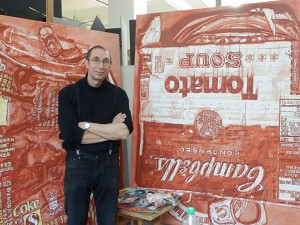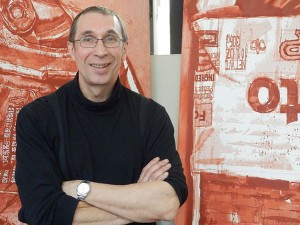A Conversation with Andrei Krioukov
As a contribution to our art vending machine, Andrei Krioukov treated and crushed Coca-Cola cans with Hebrew and Arabic labels. I met him and his wife Rita at their art school on Immanuelkirchstraße in Berlin. This is where Andrei teaches international students, who both study and take their state-recognized exams with him.
In our discussion Andrei talks about his fascination with the design of the famous cans and explains the elements of both trash and art they represent.
Christiane Bauer: Andrei, what fascinates you about the Coca-Cola can?
Andrei Krioukov: These cans are typical of our lives today. You can find them everywhere, but hardly anyone notices them. For me, the discrepancy between art and trash is an exciting subject: if a can is lying on the street, it’s trash. But if I pick it up and contemplate it, and I ponder what I can do with it, it turns into art.
An artist from the 19th century could paint garlic, an onion, or a pitcher of water. Today our lives are full of Coca-Cola cans.
The pitcher appeared in still life paintings as an object from everyday life. What significance does the can have? Do you see a can of Coke as a disposable article or as a modern cultural artifact?
Some people think that I paint the Coca-Cola brand. I don’t paint Coca-Cola, but rather, the typical trash of today that you find lying on the street everywhere – in Israel, Palestine, America, or China. You could look at the crushed can of Coke as an icon of globalization.
Does the crushed Coca-Cola can convey an element of criticism?
There’s no criticism intended. Coca-Cola is just a very strong brand. And that’s not a bad thing. We all use and exploit that. Aside from being an icon of globalization, to buy and enjoy a can of Coke gives us a brief feeling of happiness…
The can itself has an interesting shape. First of all, it’s a classic cylinder. But when it’s crushed, it takes on a new, much more interesting, shape. From a graphic perspective it generates a whole new pattern.
Do you have a standard method of crushing cans?
Before each treatment, I look very closely at the can and consider what shape would be interesting and what pattern could emerge from it. As such, I’m not actually crushing cans but creating a little sculpture. Crushing the cans can generate a pattern of folds, with the underside and top of the can, the label and barcode: it should end up being an interesting object. Practically speaking, I work like a sculptor. I rely on my artistically trained eye and my understanding of form. Even while painting, I don’t simply make a copy of the can but rather, look at it very closely and think about how to bring the rhythm of the can onto the flat surface of the painting.
How long have you been working with this form?
For about four years. We came to Berlin from Kassel and I was looking for something new.
We had our art school at the Kulturbrauerei (culture-brewery) in those days. On Fridays and Saturdays a lot of people would party in the big clubs there. On Sundays the ground would be covered with cans, beer bottles, and bottle caps. And suddenly I realized: “This is my subject!” I stumbled across it, so to speak.
Would you tell me more about the form you developed of ‘one-way realism?’ What is it exactly and how did you arrive at this concept?
‘One-way realism’ is a term that I coined myself, because the objects that I work with are disposable. We use them once. That’s not a tragedy because we also live just once. Everything that happens in our lives happens only once. That’s a schema that the Coca-Cola can expresses for me. We use it, drink the contents, and then throw it away.
Do you remember the first Coca-Cola that you drank?
The first time I saw Coca-Cola was in Bulgaria. In 1986.
The Bulgarians had a different attitude towards life than the Russians. Bulgaria was warm and interesting. I’d often been to the Black Sea on the Russian coast, but the sea on the Bulgarian side had a completely different color! On the Russian side you always looked towards the sun, so you couldn’t see any color. The Bulgarian side is further West, so when I looked at the sea the sun wasn’t blinding.
Bulgaria also had pizzerias. I saw this all for the first time and drank my very first Coca-Cola there. (He laughs.)
Thank you for the conversation!
For further information on Andrei Krioukov visit his website at www.krioukov.de or that of Andrei and Rita Krioukov’s “School for Visual Art and Design” at www.kunstschuleberlin.de.


